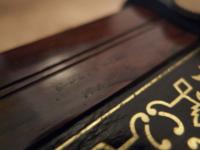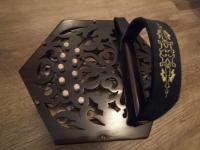
gavdav
-
Posts
205 -
Joined
-
Last visited
Posts posted by gavdav
-
-
and me too - I think G in this style on a C/G is a bit too squeaky, whereas D on a G/D is quite pleasant - the same as you'd hear the average english concertina playing in D. Bm is a dream as well, I need to learn more Bm tunes!!!
-
Due to an error, I missed two guests from the flyer.Iren Shettle and Ralph Jordon will be performing over the weekend and giving their illustrated talk on the songs collected by Lucy Broadwood.
Fantastic Mark - looks super, have put it in my diary and hope to get along. Who knows I might even get a sing with my folks

-
The ebony will be tricky to find and you would probably need to use several layers of modern veneer to make the thickness of one layer of 19th century veneer.
I've had some success is finding hardwood veneers from Craft Supplies in Millers Dale - they sell packs for a few pounds with a selection in which I have found big enough for guitar headstock plates - they may be able to find you something if you're in the UK. It may need to be ebonised with an iron stain or something similar before french polishing. There's a place in Witney sells french polishing supplies appropriate to this job by mail order. (i.e. small volumes of black french polish!)
-
Hello - I'm looking at my concertinas in the Wheatstone ledger. I understand the date, model description and serial number columns - what do the other two columns indicate? Is the first column model number? Do the diagonal lines indicate that the gaps are filled by identically specced models? I am looking at this page:
http://www.horniman.info/DKNSARC/SD02/PAGES/D2P0500S.HTM
thanks in advance
Gav
Gav,
Yes, model # to the right of the date. Anything within the field of the diagonal is a similarly appointed instrument.
To find the model # descriptions consult the price lists that are found under particular concertina systems at concertina.com
Greg
Thanks Greg - what about the number after the descript. but before the serial?
-
Hello - I'm looking at my concertinas in the Wheatstone ledger. I understand the date, model description and serial number columns - what do the other two columns indicate? Is the first column model number? Do the diagonal lines indicate that the gaps are filled by identically specced models? I am looking at this page:
http://www.horniman.info/DKNSARC/SD02/PAGES/D2P0500S.HTM
thanks in advance
Gav
-
Steve's 61 button seems to be the Anglo Daddy; my 50 button is pygmy by comparison.
Neil
I have a 50 key as well - half an inch smaller than that monster of steve's across the flats,but a very different layout to yours.
I've seen a thread some time back about big boxes -
JimLucas, on Jun 25 2004, 01:34 PM, said:you might consider tracking down the custom anglo that Ron Shuttleworth had made for him many years ago, to see if the current owner would like to sell. As I recall, it had 60-odd buttons with 3 or 4 "central" keys. I think Crabb built it for him. When I saw it (about 30 years ago) he said he wanted to sell it, because he had decided it was too heavy to be practical.
It sounds a bit like a (duet-sized) Wheatstone Aeola anglo that Paul Davies had about ten years ago. A wonderful machine, but hard work to play. The story was that It had been made in the 1920's for a boxer.
Not sure about Ron's box - but might it even outsize Steve's??? And who knows where that 20s wheatstone is? Both of mine were made in 1926 - page 50 of the ledger down the bottom...
-
As far as I can see most of the notes facilitate chording and single direction runs - a very different style of playing to normal on an anglo (for me!) and I guess designed to open up more duet-like possibilities.
-
"key" indicates which note is the tonic or harmonic basis of the piece of music or scale you're playing.
The other thread is based on Anglo concertina, so that's what I'll mention here. The Anglo concertina has "home" keys - those in which it plays most easily up and down the rows. The given key is dictated by the notes which make up the scale. On a normal C/G anglo the standard push pul pattern will give you the key of C - C,D,E,F,G,A,B,C
To play in other keys might mean playing across the rows in non-obvious patterns.
In F you need to play F,G,A,Bb,C,D,E,F which is not too tricky on the C/G anglo but can't be accomplished up a single push pul row and therefore requires a little more brain and finger power to work out.
Having resisted it for a long time (why???) I can heartily recommend drawign out a diagram of where all the notes are on your box and having a look at some different scale patterns. This wiki link has been helpful to me too.
-
I'm puzzled, especially by the collection of "drones" at the bottom.
Could you precise in which octave are these notes ?
Left hand is the octave below the standard bass notes, right hand is the octave of the D row treble notes.
-
Got bored, after waiting five minutes for the link.
Sorry guys - maybe someone more technically minded can explain it. It takes about eight seconds to come up on my connection but all the image links on the site seem slower today than usual.
-
sorry guys - file was much too large so I have deleted and re attached. please see if it worked!
-
No prob - I thought I'd got C working nicely in both hands, but the directions are making it a little trickier!
-
If I'm looking at the post I just have to click it, but you could try right clicking and saving the linked file.
-
If I'm looking at the post I just have to click it, but you could try right clicking and saving the linked file.
-
This is pulling together some other things from other threads. I am currently getting my head round this concertina - I love it, but i am sure there is an internal logic that I'm only seeing part of, being less musically minded than the average person (when it comes to dots and theory). It is a G/D with a lot of extra buttons. What I have found is that playing in A major and B minor are as easy as playing in G and D and in Bm especially all those extra drones add a lot. Can anyone see any other convenient scales? I have corrected the layout I posted earlier and this one should be correct (if odd). I tend to play by shape and pattern in the "English" anglo style.
Any input much appreciated.
-
one of the amazing things about the box in question is the brazillian rosewood ends - hard to make new ones without great expense and possibly best repaired with veneered or indian rosewood parts rather than totally replaced. Certainly they don't build them like that anymore.
-
I'd been playing Peter Bellamy's song "Fakenham Fair" for a while and realised it makes a pretty decent cheerful waltz. Has elements of Rosin The Bow about it but thought someone might like it.
posted my first stab at it on youtube here...
-
I got this over the weekend and think it is fabulous - wouldn't normally be my first choice of musical style but it is quite sublime - understated and awe inspiring at the same time.
-
totally - I guess you're used to playing Irish style - I liek my core of a tune to be on three adjacent buttons, english style - I just found that duped button gave me melodeon style convenience! (and was less finger mangling)
-
Opps posted when I'd misread the pushes and pulls in mike's original layout...
I think I'd want that f/f button on the right hand to be e/d as well
-
Hello - resurrecting this age old thread to see if anyone can find out any more about these. I own one and it doesn't appear to match up to any logic of even the Jeffries duet - the key layout doesn't seem to be Jeffries duet layout, nor does the stamping of reed shoes suggest that all that much fiddling went on. Many people have now looked at mine and said "not a converted duet" though it hardly matter to me if it is or isn't.
I'd really like to know if anyone else out there owns one that I can compare with. The history of these is intriguing me. My concertina may even be the one in the thread above!
-
If it was a Jeffries it would have C.JEFFRIES MAKER stamped into the wood on a side.
The seller said he couldn't see any brandings on it, making it an early Crabb.
The seller may not have been able to spot them - mine of very similar vintage had no visible markings until it was restored. Mind you, that 26 key is going to need a good £600 worth of work on it looking at those pics!
You could by this lovely pristine 20 key I'm selling (I'm open to offers!!!) and add some extra buttons

Here is the evidence you probably don't want to see - compare my 20 key to the wreck up above and they're pretty similar .
-
Hi All For those of you who accompay youself singing are you conscious of A.Playing along to your singing or B. Singing along to your playing ?I think I play to my singing .I rcentley heard someone playing a church organ and he was definitaly following the solo singer .I suppose its possible to do either way .Any thoughts ? Bob
I started singing to the tune, then found that the more I did it the freer I became, in the end I have arrived somewhere in the middle by happy accident.
-
My own view about modifying layouts is that one should be very wary of altering the "core" 30 buttons. This is consistent with my view that we are less owners of these things as custodians. OTOH there is so much variability amongst the "extra" buttons that I have tended to regard them as fair game for alteration.
Chris
PS Thanks for the link, but it should be this. The link generator seems to be misbehaving.
agreed Chris - I just changed the "extra button" ont he low end of the D row of my 46 key to gie the A/B in the same direction - this just meant I had a sequence of a/b/Csharp/d in a sensible sequence!




Wheatstone anglo special
in Concertina History
Posted · Edited by gavdav
We could do with a new "boxzilla" thread for these things
Someone mentioned there were "numerous" AG duets in the wheatsone ledgers, but I haven't seen very many - I guess they would all fall into this category.
Steve - there is a link inside Neil's thread to his pics.